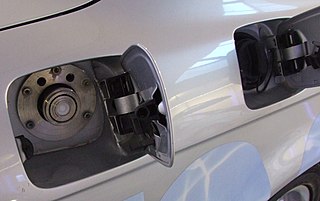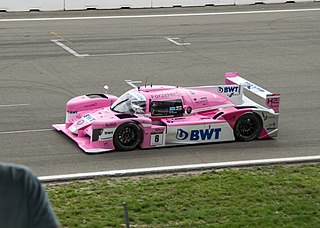A hydrogen vehicle is a vehicle that uses hydrogen fuel for motive power. Hydrogen vehicles include hydrogen-fueled space rockets, as well as ships and aircraft. Power is generated by converting the chemical energy of hydrogen to mechanical energy, either by reacting hydrogen with oxygen in a fuel cell to power electric motors or, less commonly, by burning hydrogen in an internal combustion engine.

The McLaren F1 is a sports car designed and manufactured by British automobile manufacturer McLaren Cars, and powered by the BMW S70/2 V12 engine. The original concept was conceived by Gordon Murray. Murray was able to convince Ron Dennis to back the project. He engaged Peter Stevens to design the exterior and interior of the car. On 31 March 1998, the XP5 prototype with a modified rev limiter set the Guinness World Record for the world's fastest production car, reaching 240.1 mph (386.4 km/h), surpassing the modified Jaguar XJ220's 217.1 mph (349 km/h) record from 1993.

A compressed-air vehicle (CAV) is a transport mechanism fueled by tanks of pressurized atmospheric gas and propelled by the release and expansion of the gas within a pneumatic motor.

A fuel cell vehicle (FCV) or fuel cell electric vehicle (FCEV) is an electric vehicle that uses a fuel cell, sometimes in combination with a small battery or supercapacitor, to power its onboard electric motor. Fuel cells in vehicles generate electricity generally using oxygen from the air and compressed hydrogen. Most fuel cell vehicles are classified as zero-emissions vehicles that emit only water and heat. As compared with internal combustion vehicles, hydrogen vehicles centralize pollutants at the site of the hydrogen production, where hydrogen is typically derived from reformed natural gas. Transporting and storing hydrogen may also create pollutants.

The Honda Clarity is a nameplate used by Honda on alternative fuel vehicles. It was initially used only on hydrogen fuel-cell electric vehicles such as the 2008 Honda FCX Clarity, but in 2017 the nameplate was expanded to include the battery-electric Honda Clarity Electric and the plug-in hybrid electric Honda Clarity Plug-in Hybrid, in addition to the next generation Honda Clarity Fuel Cell. Clarity production ended in August 2021 with US leases for the fuel cell variant continuing through to 2022.

The Toyota FCHV is a current hybrid hydrogen fuel cell vehicle development programme of the Toyota Motor Corporation, which was leased to a limited number of drivers in the United States and Japan beginning in 2002. "FCHV" stands for "Fuel Cell Hybrid Vehicle". A number of prototypes have been produced, up to the latest FCHV-adv ("advanced").

HydroGen3 was an Opel hydrogen fuel cell concept vehicle used for testing in 2006. HydroGen3's 400-kilometer (250 mi) driving range is the highest of any fuel cell vehicle approved for public roads in Japan. The five seater front-wheel driven prototype is based on the Opel Zafira compact MPV.
The Honda FCX is a family of hydrogen fuel cell automobiles manufactured by Honda.

The Mazda Premacy Hydrogen RE Hybrid or Mazda5 Hydrogen RE Hybrid was a hydrogen powered hybrid car produced by Mazda. Later models were also called the Mazda Hydrogen RE Plug in Hybrid. The first car was unveiled in 2005, with an improved version shown at the 2007 Tokyo Motor Show. Mazda planned for the car to enter production and leased a few cars to end users in 2009 in 2010.

A hydrogen internal combustion engine vehicle (HICEV) is a type of hydrogen vehicle using an internal combustion engine. Hydrogen internal combustion engine vehicles are different from hydrogen fuel cell vehicles. Instead, the hydrogen internal combustion engine is simply a modified version of the traditional gasoline-powered internal combustion engine. The absence of carbon means that no CO2 is produced, which eliminates the main greenhouse gas emission of a conventional petroleum engine.

Forze is a student team specialised in hydrogen electric racing. It was founded at the Delft University of Technology in 2007 by Edgar van Os and has built 8 hydrogen fuel cell racing vehicles. The team's offices and workshops are located at the Schiehal in Delft, an old factory terrain in which many innovative companies have settled. In 2007, the team began designing and building go-karts with a hydrogen-electric drivetrain. With these vehicles they participated in the Formula Zero competition, hence the name ForZe. After five years the first full-size hydrogen race car was built, the Forze VI. Another three years later the project of the Forze VII began. This became the first hydrogen-electric racecar to ever participate in an official race against fossil-fueled vehicles. The latest iteration, the Forze VIII, was the first hydrogen-electric race car to ever beat petrol powered cars, and came in 2nd place at the Gamma Racing Days in Assen in 2019. Over the coming years the team wants to develop its cars in such a way that they can compete in a Le Mans Prototype endurance series.

The Mercedes-Benz BlueZERO concept is Mercedes' attempt at the alternative fuel vehicle movement. The BlueZERO is a flexible concept that has the ability to accommodate the three different types of future alternative fuels: electric, hybrid, and hydrogen fueled. It was first introduced at the 2009 Detroit Auto Show which took place January 11–25. It features a single vehicle architecture that accommodates three models with different electric power-train configurations, each of which are fully developed and ready for testing. The Mercedes-Benz BlueZERO electric drive system gives each model the same performance specifications for acceleration and top speed. The Mercedes-Benz BlueZERO electric drive modular design accelerates from 0 to 100 km/h (62.5 mph) in under 11 seconds, and the top speed is electronically governed to 150 km/h (93 mph) in the interests of optimal range and energy efficiency. Peak torque is 320 N⋅m (236 lb⋅ft) and as with all EVs, maximum torque is available from zero rpm.
The General Motors Stir-Lec I was a concept hybrid electric car based on the Opel Kadett body in 1969. The power plant consists of 14 lead-acid batteries in the front of the car which transfer energy to a rear-mounted 3 phase electric induction motor, in turn driving the rear wheels. The Stir-Lec I had a top speed of 55 mph (89 km/h). While the car is running, the batteries are constantly recharged by a small Stirling engine in the rear. The engine was allegedly so quiet it was hard to determine if it was running or not, just by sound. Since the Stirling is an external combustion engine, the exhaust has virtually no odor and pollution levels can be made very low.

The McLaren P1 is a limited-production mid-engine plug-in hybrid sports car produced by British automobile manufacturer McLaren Automotive. Debuted at the 2012 Paris Motor Show, sales of the P1 began in the United Kingdom in October 2013 and all 375 units were sold out by November. Production ended in early December 2015. The United States accounted for 34% of the units and Europe for 26%.

The Toyota Mirai is a mid-size hydrogen fuel cell vehicle (FCV) manufactured by Toyota, and is one of the first FCV automobiles to be mass-produced and sold commercially. The Mirai was unveiled at the November 2014 Los Angeles Auto Show. As of December 2021, global sales totaled 17,940 units; the top-selling markets were the U.S. with 9,274 units, Japan with 6,618 and the rest of the world with 2,048.

The Hyundai ix35 FCEV or Tucson FCEV is a hydrogen fuel cell electric vehicle developed by Hyundai. The model is a left-hand drive only conversion to the SUV platform it is based on and was the first of its type to be mass-produced and sold commercially in the world. Different versions are known, the previous version was based on the Hyundai Tucson FCEV, and the upcoming model is based on the current ix35 FCEV. The first generation was introduced in 2001, with the Hyundai Santa Fe FCEV, and had a range of 100 miles (160 km), with a top speed of 78 mph (126 km/h).

The Mazda HR-X was the first hydrogen powered concept car produced by Mazda. The car was unveiled at the Tokyo Motor Show in 1991. The car seated four people in a plastic shell and was powered by a two rotor Wankel engine which propelled it to 130 km/h (81 mph). The hydrogen was stored in a cooled metal hydride tank and 3.32 kilograms (7.3 lb) provided a range of 190 km (120 mi). It was the first in a series of demonstration hydrogen internal combustion engine vehicles produced by Mazda.

The Ferrari SF90 Stradale is a mid-engine PHEV sports car produced by the Italian automobile manufacturer Ferrari. The car shares its name with the SF90 Formula One car with SF90 standing for the 90th anniversary of the Scuderia Ferrari racing team and "Stradale" meaning "made for the road".

The Gumpert Nathalie or RG Nathalie is a hydrogen-electric hybrid sports car running on methanol to generate hydrogen that is scheduled to enter production in 2021. It is the first car produced by the new car manufacturer RG founded by Roland Gumpert, following the bankruptcy of his company Gumpert which produced the Apollo. Production is planned to be limited to 500 cars.

The Hyundai Vision FK is a concept car that uses a plug-in hybrid drivetrain with both a large traction battery and a hydrogen fuel cell; the concept vehicle was developed by Hyundai and Rimac Automobili. The mid-motor, rear-wheel-drive sports coupe was unveiled at the Hydrogen Wave Forum in September 2021, an event organized by Hyundai to outline its plans to popularize hydrogen vehicles by 2040 for "Everyone, Everything and Everywhere". Power is delivered through two electric traction motors, both on the rear axle. The Vision FK can be plugged in to recharge its traction battery, which has more than 60 kW-hr of energy storage capacity, and the onboard fuel cell affords it a range greater than 600 km (370 mi).

















